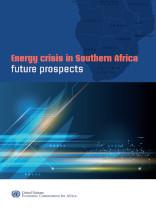Energy crisis in Southern Africa - Future prospects

The paper is divided into four sections, starting with the “Introduction and background”, which analyses the socioeconomic environment in all SADC countries, and ending with an assessment of the institutional structure within which the energy sector in the region operates in. From section II onwards, the focus is on the member States of SADC since they are interconnected or are in the process getting interconnected through electric infrastructure making the analysis much more comprehensible. The paper focuses on electric energy, a prominent sector for all the national economies.
Section II, “Understanding the energy crisis in Southern Africa”, unpacks the crisis by analysing its impact and the measures undertaken collectively and individually to manage it. The section also assesses how the private sector attempts to address the crisis, and concludes by analysing electricity tariffs, how they contributed to the crisis, and the impact of cost reflectivity on the crisis.
Section III, “Planning for the future”, scrutinizes and presents the different measures, instruments and features that create a robust, efficient and responsive power infrastructure that not only addresses the current crisis and shortcomings of the current infrastructure, but offers a dynamic system to help meet the SADC development agenda and the African Union Agenda 2063. The section presents an overview of best practices in policy and governance frameworks, the role of sustainable energy technologies, cross-cutting issues, such as gender and climate change and the role of international cooperation in technology transfer. It concludes by assessing the financial instruments that can help bring in the infrastructure needed.
Section IV provides the conclusions and recommendations to member countries, the SADC secretariat and its agencies.